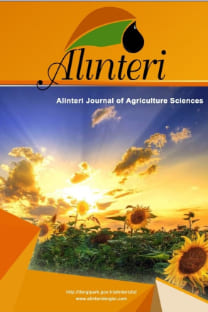Investigation of Water Quality and Pollution Level of Lower Melet River, Ordu, Turkey
___
Akbulut, M., Kaya, H., Celik, E.S., Odabasi, D.A., Odabasi, S.S. and Selvi, K.,2010. Assessment of surface water quality in the Atikhisar Reservoir and Sarıçay Creek (Çanakkale, Turkey). Ekoloji, 19(74), 139-149.Anonymous, 1984. Methods 604. Phenols in federal register. October 26, Part VIII, 40cfr, Part 136, EPA, Washington, DC.
Anonymous, 1996. Guidelines for drinking water quality (2nd edition) Volume 2. Health criteria and other supporting information. WHO, Geneva.
Anonymous, 2011. Guidelines for Drinking-water Quality Fourth Edıtıon, Geneva 27, Switzerland. 564 s. WHO.
Anonymous, 2015. Regulation on the surface water quality management. Number of official gazette: 29327.
Bayram, A., Onsoy, H., Bulut, V.N. and Akinci, G., 2013 Influences of urban wastewaters on the stream water quality. A case study from Gumushane Province, Turkey. Environmental Monitoring and Assessment 185: 1285–1303.
Boyd, C.E. and Tucker, C.S., 1992. Water quality and pond soil analyses for aquaculture. Alabama agricultural experiment station, Auburn University, Alabama, USA.
Boyd, C.E., 1995. Bottom Soils, Sediment, and Pond Aquaculture. Chapman & Hall, New York.
Boyd, C.E. and Tucker, C.S., 2014. Handbook for aquaculture water quality, Craftmaster Printers, Inc., Auburn Alabama, USA.
Bozkurt, A. and Tepe, Y., 2011. Zooplankton composition and water quality of Lake Gölbası, (Hatay- Turkey). Fresenius Environmental Bulletin 20: 166-174.
Chapman, D. 1996. Water Quality Assessments. A guide to use biota, sediments and water in environmental monitoring, Second Edition. University Press, Cambridge, London, 609 s.
Couto, S. R. and Herrera, J. L. T. 2006. Industrial and biotechnological applications of laccases: a review. Biotechnology advances, 24(5), 500-513.
Gardziella, A., Pilato, L. and Knop A. 2013. Phenolic resins : chemistry, applications, standardization, safety, and ecology. Berlin Heidelberg: Springer-Verlag.
Gedik, K., Verep, B., Terzi, E. and Fevzioğlu, S., 2010. Determination of water quality of Fırtına Stream (Rize) in terms of physico-chemical structure. Ekoloji 19(76): 25-35.
Goerlitz, D.F., Troutman, D.E. and Gody, EM., 1985. Migration of wood-preserving chemical in contaminated groundwater in a sand aquifer at Pensacola, Florida. Environmental Science & Technology 19:955-961.
Hacioglu, N. and Dulger, B., 2009. Monthly variation of some physico-chemical and microbiological parameters in Biga Stream (Biga,Canakkale, Turkey). African Journal of Biotechnology 8 (9): 1929-1937.
Ijeoma, K. and Achi, O.K., 2011. Industrial effluents and their impaction water quality of receiving rivers in Nigeria. Journal of Applied Technology in Environmental Sanitation 1(1): 75-86.
Iscen, C.F., Emiroglu, O., Ilhan, S., Arslan, N., Yilmaz, V. and Ahiska, S., 2008. Application of multivariate statistical techniques in the assessment of surface water quality in Uluabat Lake, Turkey. Environmental Monitoring and Assessment 144 (1-3): 269-276.
Ling, T.Y., Achberger, E.C., Drapcho, C.M. and Bengtson, R.L., 2002. Quantifying adsorption of an indicator bacteria in a soil–water system. Transactions of the American Society of Agricultural Engineers 45: 669–674.
MGM. 2015. Annual Rainfall and Temperature Data, (http://www.mgm.gov.tr/veridegerlendirme /yillik-toplamyagis-verileri.aspx, 08.02.2015).
Michałowicz, J. and Duda, W. 2007. Phenols—sources and toxicity. Polish Journal of Environmental Studies, 16(3), 347-362
Mutlu, E., Yanık, T. and Demir, T. 2013. Horohon Deresi (Hafik-Sivas) Su Kalitesi Özelliklerinin Aylık Değişimleri/Horohon Stream (Hafik-Sivas) Water Quality Characteristics and Monthly Variations. Alınteri Zirai Bilimler Dergisi, 25(2).
Mutlu, E. and Uncumusaoğlu, A. A.2016. Physicochemical analysis of water quality of Brook Kuruçay. Turkish Journal of Agriculture-Food Science and Technology, 4(11), 991-998.
Mutlu, E., Kutlu, B. and Demir, T. 2016. Assessment of Çinarli Stream (Hafik-Sivas)'S water quality via physicochemical methods. Turkish Journal of Agriculture-Food Science and Technology, 4(4), 267-278.
Özbay, Ö., Göksu, M., Alp, M.T. and Sungur, M.A., 2013. Berdan Çayı (Tarsus-Mersin) Sedimentinde Ağır Metal Düzeylerinin Araştırılması. Ekoloji Dergisi, 22(86), 68-74.
Palma, P., Alvarenga, P., Palma, V.L., Fernandes, R.M, Soares, A.M. and Barbosa, IR., 2010. Assessment of anthropogenic sources of water pollution using multivariate statistical techniques: a case study of the Alqueva's reservoir, Portugal. Environmental Monitoring and Assessment 165: 539–552.
Phyllis, K.W. and Lawrence, K.D., 2007. Effects of total dissolved solids on aquatic organisms: A review of literature and recommendation for salmonid species. American Journal of Environmental Science 3: 1- 6.
Renzi, M., Giovani, A. and Focardi, S.E., 2012. Water Pollution by Surfactants: Fluctuations Due to Tourism Exploitation in a Lagoon Ecosystem. Journal of Environmental Protection 3: 1004-1009.
Tanyolaç, J. 2011. Limnoloji (Tatlısu Bilimi). Hatiboğlu Yayıncılık, Ankara. 294 s.
Taş B., 2006. Investigation of Water Quality of Derbent Dam Lake (Samsun). Ekoloji 15(61): 6-15.
Tepe, Y. and Mutlu, E., 2004. Arsuz Deresi (Hatay) Su Kalitesinin Fiziko-Kimyasal Yöntemlerle Belirlenmesi.Türkiye’nin Kıyı ve Deniz Alanları V.Ulusal Konferansı Bildiriler Kitabı, 4-7 Mayıs 2004, Çukurova Üniversitesi, Adana, Cilt:2, 705-711.
Tepe, Y., Türkmen, A., Mutlu, E. and Ateş, A., 2005. Some physico-chemical characteristics of Yarseli Lake, Hatay, Turkey, Turkish Journal of Fisheries and Aquatic Science 5 (1): 35-42.
Tepe, Y., 2009. Determination of the water quality of Reyhanlı Yenişehir Lake (Hatay). Ekoloji 18(70): 38-46. .
- ISSN: 2564-7814
- Yayın Aralığı: 2
- Başlangıç: 2007
- Yayıncı: Adem Yavuz SÖNMEZ
Enas A. Hamad ATEA, ALİ ESLEM KADAK, Adem Yavuz SÖNMEZ
Investigation of Water Quality and Pollution Level of Lower Melet River, Ordu, Turkey
FİKRET USTAOĞLU, A. YALÇIN TEPE, Handan AYDIN, Abuzer AKBAŞ
ABDULKERİM DİLER, OLCAY GÜLER, RECEP AYDIN, METE YANAR, RIDVAN KOÇYİĞİT
Karadeniz’deki Jelimsi Organizmalar (Makrozooplankton) ve Etkileri
ZEKİYE BİRİNCİ ÖZDEMİR, SÜLEYMAN ÖZDEMİR
Determining The Water Quality of Maruf Dam (Boyabat–Sinop)
